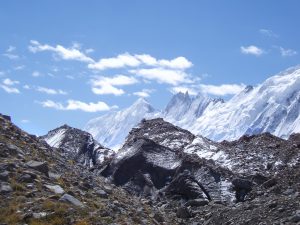Mongolia is the country of endless plains and eternal blue skies. Eighty percent of the land area is covered by grassland, giving home to about 35 million horses, cattle, sheep, goats, and camels. Half of the country’s population of 2.7 million depends on livestock production, which contributes more than 20% of the country’s GDP. More than these numbers can tell, nomadic pastoralism is a way of life. For centuries, herders have roamed the grasslands “following our animals,” as the herders’ adage goes, building, packing, and rebuilding their traditional gers, or tents, to make their living from nature’s bounty.
And, yet, this ancient lifestyle is under threat. A decade ago, herders first observed the impacts of climate change with the increase in severe weather events like storms, droughts and extremely harsh winters, known as zud. The 2010 zud was one of the worst ever, resulting in the death of approximately 8.5 million livestock or 20% of the 2009 national herd. That year, 770,000 herders were affected, of which 43,500 were left without a single animal; 164,000 lost more than half of their livestock. Herders and the government alike were not prepared and ill-equipped to deal with the consequences despite ample warning.
The 2009 national assessment on climate change in Mongolia summarised a number of major trends: since 1940, the annual mean temperature has increased by 2.14 degrees Celsius, winter precipitation has increased and warm season precipitation has slightly decreased. Recent research on climate change projections for the rest of the century suggests that winters will become milder and snowy; summer seasons will become warmer; annual precipitation will increase up to 20%; and anomalous climate phenomena, such as extreme winters, will become a common feature. Nomadic livelihoods, which fully depend on the weather, are becoming increasingly vulnerable as a result.
However, increased vulnerability is not only caused by the impacts of climate change. Overgrazing has also played a role in degrading scarce natural resources. Up to 30% of Mongolia’s grassland biomass production has been lost over the past 40 years. At the same time, the Gobi desert, which dominates the southern half of the country, has been steadily expanding north at a pace of 150 kilometres every 20 years. When traveling through central Mongolia, one can easily observe this process firsthand—where a few years ago there were still pastures and patches of cropland, now only sandy fields remain.
Overgrazing has been stimulated by the collapse, in the early 1990s, of the country’s Soviet-style control of agriculture, which had involved a communal system to manage land and herds. Since then, land has remained state owned, but livestock has been privatised, giving herders a strong incentive to increase the size of their herds. Under this trend, combined with a prolonged period of relatively pleasant, soft winters at the end of the twentieth century, the livestock population in Mongolia rapidly reached 30 million head for the first time in its history. The result was disastrous: wide-scale overgrazing and pasture degradation. Since 2006 rural poverty has been increasing, despite overall growth in the Mongolian economy. The provision of social and economic services for rural areas (including health care, education, transportation, communication and credit) has remained poor or collapsed altogether.
The government has begun to respond to the threat to herders and their way of life. In a number of regions across the country, herders, in collaboration with local governments and researchers, and supported by a number of new policy measures and laws, are practising co-management, a form of adaptive management that builds community resilience. The concept has been popularised by the academic and activist H Ykhanbai.
Since the 1990s, when the scale of Mongolia’s degradation became apparent, Ykhanbai has sought an alternative to both top-down and laissez-faire development strategies. Ykhanbai was uniquely suited to the task: raised in a herder family in the far away Altai Mountains, he attended the University of St. Petersburg, Russia, where he studied Garrett Hardin on the “tragedy of the commons” and economist Elinor Ostrom on collective action. Ykhanbai understood that pastures in Mongolia are a common pool resource shared by many users, while private ownership of livestock allows herders to become real managers of their own businesses. Sustainable management of herds therefore depends on the carrying capacity of pastures and on the interactions between neighboring herders who rely on the same resources.
In Ykhanbai’s words, “I gained this knowledge from childhood, as a herder. The limited capacity of herders and local government to sustainably manage pasture resources can be complemented by the participation of other stakeholders at various levels. Together, they can manage the resource base more effectively. The increasing desertification and widespread climate change impacts require action at levels higher than the individual household or single community.”
NEXT: How one community has transformed itself
Ronnie Vernooy is a rural development sociologist with a particular interest in agricultural biodiversity and natural resource management. This article first appeared in Solutions journal. It is reproduced here with permission.
Image courtesy of Shuny


